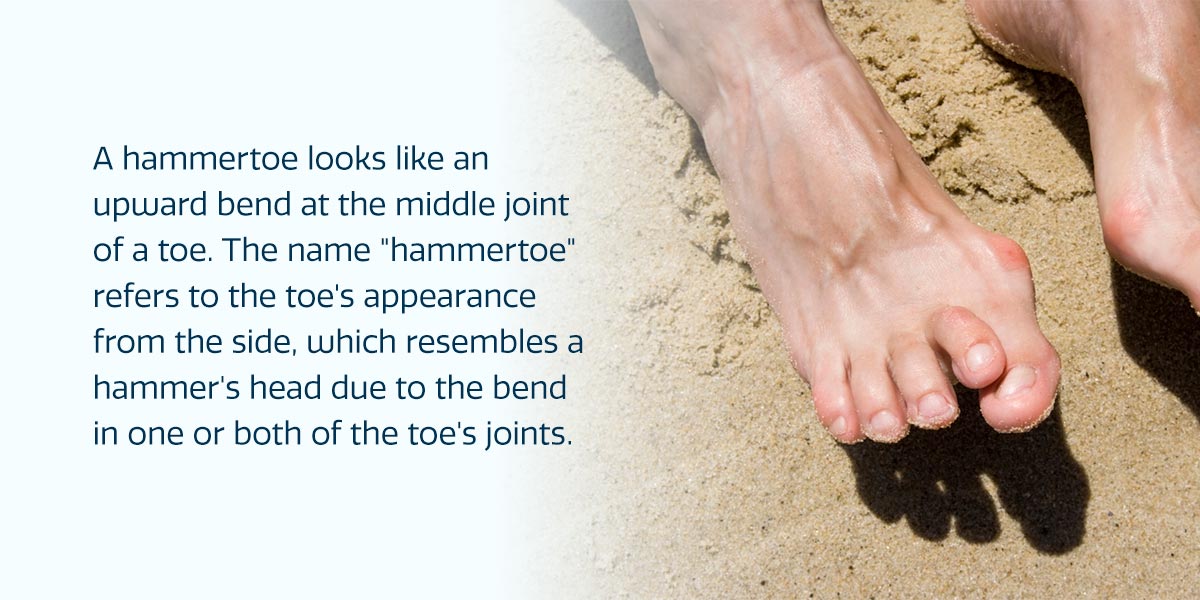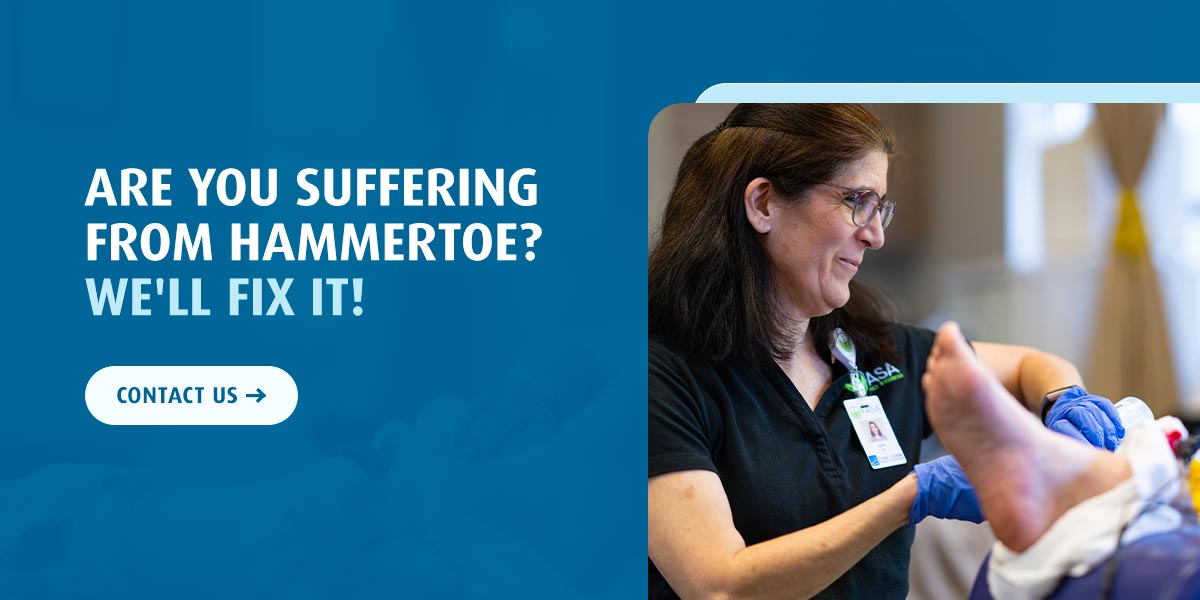Hammertoes, sometimes known as “curled” or “bent” toes, are a common cause of foot discomfort and a source of self-consciousness about how your feet look. The second toe adjacent to the big toe is typically affected by hammertoe. However, it can also affect the third or fourth toes. It usually affects the toe’s middle joint, which bends downward. Even though this foot deformation is not a medical emergency, it can worsen over time, and surgical treatment may be necessary to fix the hammertoe. If you have or have ever experienced hammertoe, you know how painful this condition can be. Fortunately, it is possible to fix hammertoe without surgery and even reverse the condition entirely. Learn more about what causes hammertoe and how to treat and prevent it.
What Is a Hammertoe?
A hammertoe is an abnormal bend in the middle joint of a toe, similar to a mallet toe. Both these abnormalities typically occur in any of the middle toes and not on the pinky or big toe. They are one of the most common deformities of the forefoot. Hammertoe affects millions of people, and many never receive a medical diagnosis for their condition or receive treatment for hammertoe.
Factors that cause hammertoe include:
- Footwear: Wearing shoes that are too tight or narrow can cause hammertoe to develop. The tip of your shoe can misalign the joints in your toes and cause them to bend. Be sure you always choose shoes that provide adequate support for your feet.
- Imbalance in the muscles: An imbalance in tendons or ligaments that normally hold the toe straight can lead to instability and cause your toe to contract.
- Trauma: A toe that has been stubbed, jammed or broken may be more susceptible to developing hammertoe after the accident.
Certain risk factors can also increase the likelihood of developing a hammertoe. These include:
- Age: The risk of developing hammertoe increases with age.
- Sex: Hammertoes typically affect women much more than they do men.
- Toe length: A second toe that is longer than your big toe increases your likelihood of developing a hammertoe.
- Diseases: Being diagnosed with arthritis or diabetes puts you at a higher risk of developing foot deformities.

How to Identify a Hammertoe
A hammertoe looks like an upward bend at the middle joint of a toe. The name “hammertoe” refers to the toe’s appearance from the side, which resembles a hammer’s head due to the bend in one or both of the toe’s joints. A doctor will need to perform a physical exam to diagnose a hammertoe and may request an X-ray. A doctor may also decide to test the feet’s nerves and muscles if they suspect another condition may be triggering the hammertoe, such as diabetes.
Living with hammertoe can be the source of much pain, discomfort and insecurity in a person’s life. A person with hammertoe may experience the following afflictions:
- Difficulty walking can result in a corn or callus appearing on the toe joint
- A rigid joint at the bend of the toe
- Pain at the bend of the hammertoe
- Swelling around the affected toe
- Difficulty wearing shoes
- Stress on other areas of your toes and feet
The Best Ways to Treat Hammertoe
While the condition is painful and disrupts your lifestyle, the good news is that there are ways to fix a hammertoe. Some cases may respond to nonsurgical methods if the affected toe is still flexible. Wondering how to fix hammertoe without surgery? Here are some of the nonsurgical procedures used to treat hammertoe:
- Physical therapy: Stretching and muscle strengthening exercises can reverse some muscle imbalances that cause hammertoe.
- Changing footwear: Avoid wearing shoes that force your toes into a bent position or are too tight or narrow. Test out high heels before purchasing a pair.
- Orthotics: These handy shoe devices can help counteract the imbalances in your foot muscle. They can also prevent imbalances by shifting the foot and toes while wearing shoes to create a comfortable fit.
- Splinting: Using splints or tape on the hammertoe can aid realignment and prevent further bending.
Surgery is possible if nonsurgical treatment does not relieve symptoms or the hammer toe becomes immobile. The procedure to correct hammertoes often uses a local anesthetic and does not necessitate a hospital stay. Resting your feet after a hammertoe surgery will help the toe heal. Available surgical treatments include:
- Tendon lengthening: This is an option if the tendons creating the imbalance are still flexible.
- Tendon transfer: A tendon transfer procedure in which ligaments are moved from the bottom to the top of the toe to enable the joint to straighten can also be beneficial for a flexible hammer toe.
- Arthrodesis: Joint fusion is performed during arthrodesis. To enable the bone to straighten out, the doctor must remove a small part through an incision made in the joint. Tendon lengthening may occasionally be used with this surgery.
It is normal for people to experience pain or swelling for four to six weeks after surgery. Light exercises in podiatrist-approved shoes may be required for a further two to six weeks to facilitate healing. Conditions such as diabetes may prolong the healing process after hammertoe surgery.
How to Prevent Hammertoe
If you think you may be at high risk of developing hammertoe, you can do a few things to prevent it from developing.
Fortunately, you can use simple methods to prevent hammertoe, such as wearing the proper footwear. Here are a few tips on how to prevent a hammertoe from developing:
- Opt for comfort when choosing shoes and avoid wearing narrow or poor-fitting shoes.
- Put down the high heels! High heels are notorious for bending the toes and forcing the feet into unnatural positions. Instead, opt for shoes with wide toe boxes and at least 1/2 an inch distance between each toe’s end and the shoe’s inside tip.
- Choose shoes with adjustable laces and straps.
- Use a shoe insert to align your toes correctly inside your shoes.
- Do regular foot exercises that strengthen and stretch your toe muscles.
- Purchase over-the-counter corn pads to relieve pressure on your toes from the top of your shoes.

Are You Suffering From Hammertoe? We’ll Fix It!
Let us help you put your best foot forward! If you are experiencing discomfort in one or more of your toes, our doctors at Foot & Ankle Surgical Associates will check your feet for hammertoe. We want to help you get back to feeling your best. Our goal is to give you a happy and healthy relationship with your feet. Give us a call at 360.754.FEET (360.754.3338) to book an appointment today so you can step forward into a pain-free life.





